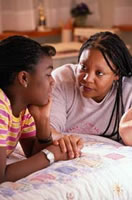Moving with Kids: Before the Move
Moving advice, moving activities & moving resources for Moving with Children of all ages.
- Expert Moving Advice for Kids of All Ages
- Before the Move
- During the Move
- After the Move
Before the Move
Moving Advice: Breaking the News to Your Kids
Most children have some semblances of a “natural explorer” or an adventurous, curious side to them. You should appeal to that explorer/adventurous side when telling kids that the family is moving. This way, you’ll help them view the move as an experience that can lead to exciting discoveries.

Telling Younger Children About a Move
Moving with Kids – Breaking the moving news to younger children Here you’ll find helpful moving advice for telling your younger children (up to age 9) about the planned move.
Remember that children have different concerns about moving at different ages. For young children and preschoolers, family is the center of their lives.
Younger children will be be curious about moving, and the concerns they may have such as being left behind and getting lost. It’s important that parents pay attention to those concerns and not treat them as trivial.
1. Explain where you are moving and why you are moving.
Be short and to the point when trying to explain the move to younger children. Use words they can understand such as, “Daddy got a promotion at work and we’re moving to where his new office will be”, or “Since your grandfather got sick, Grandma needs our help. We’re moving to be closer to them”, or also “We need a much bigger house and we’ve found a place that has what we all need.”
2. Highlight benefits of moving that your kids can understand.
For example, if you say that that you’re moving to another town because the schools there are better, may likely not have much meaning to younger children. However, pointing out that the new schools will have more activities your child will enjoy, such as more sports programs if your child likes sports or a band if your child plays an instrument (or wants to), are reasons that your kids can comprehend and look forward to.
3. Use maps and pictures as illustration to make the move more concrete.
If your children can understand maps, have one that shows your new community where you are moving to. Together, locate where you will be living and places of interest around your new place. If you are moving far, have a map that shows where you are now and where you’re moving. Help them trace the distance and even plot out a route you might take when moving from here to there. If possible, have photographs of the community and your new home that your kids can appreciate.
4. Reassure them that their life won’t change dramatically.
Do point out the things that you know will be basically the same in their new home and community, such as having a backyard to play in and going to school. Explain that pets and favorite toys or belongings will go with them. If there are lessons or other activities your kids enjoy now, assure them that you’ll find new instructors or similar programs for them in your new community.

Before the Move: What Emotions to Expect From Younger Children
Moving to a new place can greatly affect children’s behavior and emotions. Moving represents change, which creates issues for every age. Younger children need routine, so throughout the moving period, aim to keep your child’s schedules and routine normal. Even as familiar surroundings change into boxes galore, if breakfast can still start with cereal in a favorite bowl and bedtime is still a ritual of tooth-brushing and bed time stories, your young kids will cope better than you might expect.
Younger kids in the family are likely to be the most eager members of the moving team. You’ll see more positive emotions and behavior associated with moving from younger kids. They will also look forward to the chance to assist you any way they can. Let your kids help by assigning tasks you know they can handle. Remember that moving will trigger anxiety too, so consider these points:
Preschoolers, toddlers, and young children in general are egocentric. When you show stress, they may think it is something they did. Be mindful of your emotions and reactions around them, and give them extra reassurance.
Even in their excitement, young children will feel sadness at leaving familiar people, places and activities. Help your kids with concrete ways to make the “old place to the new place” transition. Follow our moving tips below to help your younger children cope with the move.
Keep note that the unknown increases anxiety. Sharing and reading children’s picture books about moving is a great way to prepare younger kids for what’s ahead and voice the range of feelings they may have.
Getting Ready:Before the Move” Moving Tips for Younger Children
- Make a list of all the Questions you have about moving. What do you want to know about the new place to where you’ll be moving?
- Create an Address Book. Who are your best friends, the ones you want to stay in touch with after you move? Make a list and get each one’s phone number, home address, and e-mail address.
- Say your Goodbyes. Who do you want to say goodbye to before you leave? Your neighbor? Your babysitter? Your dentist? Make a list of all the people you want to say your farewells to, and some of these people you can call or e-mail, or some you can give a farewell hug.
- Make a last visit to your favorite places. Think of your favorite places (like the park or the library or the candy shop) that you want to visit one more time before you move away. If it’s a long list, choose your top three favorite places and make. Talk to your parent(s) about when you can go.
- Plan your new bedroom. Draw a floorplan for a really cool bedroom in your new home. Think about the colors you want, the decorations, where to put your bed and toys.
Telling Teens & Pre-Teens About a Move

Some pre-teens and teenagers will be excited at the idea of moving and your news will be met with squeals of delight. However, if you suspect that won’t be the case with your teenager, don’t worry — you’re not alone.
Moving is often hardest on young adolescents and teenage children because as you well know that at this age, friends are vitally important. Moving means giving up these friendships and having to form new ones. And since fitting in with peers is of prime concern for your pre-teen or teen, he or she may worry about what kids are like where they’re moving and who will be their new friends.
Whether you’re expecting delight and excitement or disdain and resistance, here is a moving guide on breaking the news to older children.
1. Telling your teen or pre-teen IMMEDIATELY is very important.
Keeping a move from your teen or pre-teen is likely to heighten emotions between you, as they may feel betrayed — that you were hiding an important secret from them. Your teenager will also need time to get used to the idea of moving, to plan and also to grieve at leaving their friends.
2. Do some homework so you can “sell” the new community to your teen.
Get ready to present the benefits of moving that your teens will agree are positives for them. Perhaps things such as they’ll finally get their own bedroom, or a basketball court in the big yard, or you’re moving to a place with more public transportation, making it easier for them to get around on their own independently. Look for a link to a talent or interest your teen has that can be explored more fully in this new community. Show them that the move will have plenty of opportunities for them personally.
3. Be straightforward about why you are moving to a new place.
Older children are better able to grasp the bigger issues of why the move is happening — even if they seem stubborn and don’t want to understand. You can explain why a promotion at Daddy’s work can’t be turned down and can benefit the whole family, or why elderly grandparents need the family nearby. Be open to having a discussion to state your reasoning, such as when your teen asks why Grandma can’t just move closer to you. Remember the importance of keeping open lines of communication. Your responses like “Because I said so” often won’t help ease the transition.
4. Share what will happen next with your teenager.
Share with them the expected timetable and how the move will work, such as if one parent will move first and the rest of the family will follow later. Explain where you are in terms of finding a new home and how your teen can be involved in the moving process. Be sure to assure your teen that his or her ideas are welcome and appreciated, even if you can’t always act on them, and that their opinions and feelings are always respected. Make sure you live up to your word!
Before the Move: What Emotions to Expect From Teens and Pre-Teens

Moving usually tends to be toughest for pre-teens and teens. The difficulty that arises during moving around your teen doesn’t mean that your teenager is purposely trying to make your life miserable. There are real developmental issues at work.
At this age, your teenager is learning how to form more long-term (and perhaps even romantic ones) relationships. The decision to move may be seen as “undoing” the hard work your teenager has put in (unconscious as it may be) to form these relationships. At a difficult stage when your older child is slowly inching outside the bounds of family and trying to form his or her own personal identity, moving is a powerful reminder that your pre-teen or teen is not yet the master of his or her own destiny. The older the child, the more these feelings, emotions, and frustrations are at play. Throughout the moving process, give your teenager space and time. Do be patient and try not to lecture or be defensive, as it may make things worse.
Your older children can be a big help to you with the move — from planning, to packing, to gathering information and helping younger siblings by easing their anxieties. Assign your teen responsible tasks and show your gratefulness as they pitch in. This will surely encourage them to help you more.
Your teenager may try to talk you out of moving or may insist on staying behind to live with a relative or friend. Experts do recommend that if your teenager is a senior in high school and especially if you are moving mid-year, you may want to seriously investigate these alternatives. Otherwise, you’ll need to be firm, state and restate that the family moves together and stays together.
Remember that the unknown increases anxiety. Together, find out as much as you can about the new community, new school, job possibilities if your teenager has one now, social activities or groups your child might join in your new place.
Your teen’s worries about losing good friends that he or she has now can be very stressful. Depending on how far away you are moving, discuss with your older kids how they can stay in touch with best friends, such as weekends together or summer vacations together.
Kids this age need to know they are heard, understood, and respected. If you and your teen have trouble communicating, your child may need a chance to open up with a trusted adult, such as a counselor, relative, coach or neighbor. If this is the case between you and your child, help make this happen because you as a parent can learn and benefit from it too.
Getting Ready:Before the Move” Moving Tips for Teens and Pre-Teens
- Keep a Journal.Write your feelings, your worries, your expectations about the move on your “moving journal.” Any notebook will do. Your journal can become your own personal memory book chronicling this big moment in your life — moving from your old home to the new. Add journal entries all through the weeks and months to come. You can also attach pictures of friends and places in your current neighborhood, and leave room to add pictures of new friends and places to come.
- Ask Questions.You’re probably wondering about your new home, like how big is your bedroom, or will you have your own bathroom? Make a list of questions. If your parents are still looking for the new home, make a wishlist of what you’d like your new house or apartment to have … just don’t expect to get everything you ask for!
- Make Plans for your New Room.When you get the word on your new bedroom, get out your drawing tools to plan out your brand new space. Figure out the new furniture placement and what colors you may want, or new theme you want for your new bedroom. Designing a new bedroom is part of the fun of moving!
- Research your new Community.Find information about your new town online. Do an Internet search for local sports teams, activities you can join, movie houses, job possibilities, stores, restaurants, places to visit—whatever you want to know!
- Research your new School. While you’re Web surfing, look up your new school. Chances are, it has a school Website. Get the lowdown on school teams, clubs, teachers, courses, and the school-year schedule.
- Update your Address Book.You’re moving – but that doesn’t mean you’ll never be in touch with your friends again! With today’s technology, you can still IM your friends, send e-mails or text messages. Now is a good time to start collecting phone numbers, e-mails, screen names, addresses, birthdays—anything to help you stay in touch with the friends you want to keep!
- Say your Goodbyes.How do you want to say farewell to your best friends? Perhaps with a going-away party? With gifts you make, or things of yours that you give to special friends as keepsakes? Think of other ideas and talk to your best friends about it too. Run your ideas by your parents, especially if you plan to throw a going-away party.
Some Helpful Moving Advice from Parents Who Have Been There

- Keep your kids in the loop on important move information.
- Find activities in the new community that build on your children’s interests.
- Visit the new school when it’s in session, so the building doesn’t seem as cavernous and your kids see students who are like them.
- Volunteer at school to be a reassuring presence for younger children.
- Visit the new community and the school before you move.
- If it feels right, let an older teen stay behind to finish school.
- Use after-school activities to help kids make friends.
- Use contacts in the old community to help you find similar programs in the new one.
- Allow an extra week for packing.
- With toddlers, keep things and routines familiar.
- Set up a toddler’s new room similar to the old one.
- If appropriate, confine a cat to one room in the new home to help it adjust.

